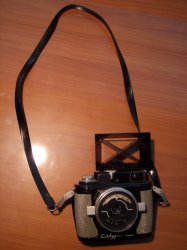For underwater photography, I'm currently using a Canon G10 and the WP-DC28 housing. I'll be "upgrading" to either the G11 and WP-DC34 housing or maybe the S90 and the WP-DC35 housing. If I wasn't using an external underwater strobe I might be more tempted with the G11, using the S90's built-in flash I'm not sure the battery would last a double-dip dive.
Speaking of which, in clear waters the diffusers on the Canon housings are good enough for close-up shooting (between 1 and 3 feet) with the on-camera flash and, in that case, you can generally get away with auto WB because there isn't enough water between the camera and subject to affect the shot.
For ambient light shots beyond about three feet (from you to the subject) the on-camera flash is worthless, maybe even less than worthless, as it just lights up the particulate matter. Also, white balance becomes a critical issue. PADI makes a cheap
white balance slate (just a flexible plastic-y card) with known values of red/green/blue/yellow bars down the side. If you are shooting JPEG with ambient light it is critical to evaluate the white balance for every time you change depth or lighting. Too much detail gets thrown out converting to an in-camera JPEG to make large corrections later in PP.
For as much as Canon offers underwater housings for a number of P&S cameras (N.B. but not all!), the button-pressing process of going back and forth from ambient light (turn off flash, set camera mode to normal, evaluate white balance) to close up (turn on flash, set white balance to auto or pick a temperature, and turn on macro mode) is a frustrating experience; you'll be setup to shoot a seahorse right when an eagle ray swims past.
Even shooting raw, evaluating white balance will give you a better starting point, but instead I just take pictures of the slate periodically so I can have good white/red/green/blue/yellow values to work from inside Lightroom or Aperture. And the cheaper cameras (like ones you might rent) may not shoot raw.
OBTW, the Ikelite housings are probably better than the Canon's (they certainly they have better depth ratings) but the Ikelites are much bulkier and also more expensive. The Ikelite 6146.11 housing for the G11 costs more than the camera (not unheard of with underwater photography) but you get eTTL control of external strobes right on the camera housing. If I'm shooting with strobes I'm more likely to be in manual and just adjust the strobe power manually as well. But a housing and two strobes wind up being a lot of bulk to deal with on a dive; a lot of times I'll leave the strobes behind esp. if I'm somewhere with small critters vs. larger marine animals or diving a wreck.
Lastly, unless your buoyancy is spot on (and even then) you'll find that you'll be all over the water column when you concentrate on the camera. Make sure you are aware of what's around you and esp. under you. No shot is worth killing a marine creature and that especially applies to coral. For this reason I'd prefer to see someone wait until sometime around their 100th dive before they start underwater photography.

Edit: Also another great resource would be the underwater photography forums on
Scubaboard.


